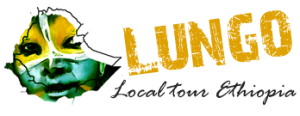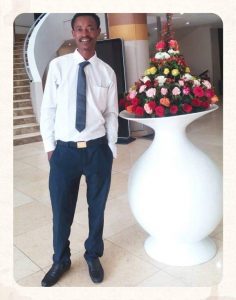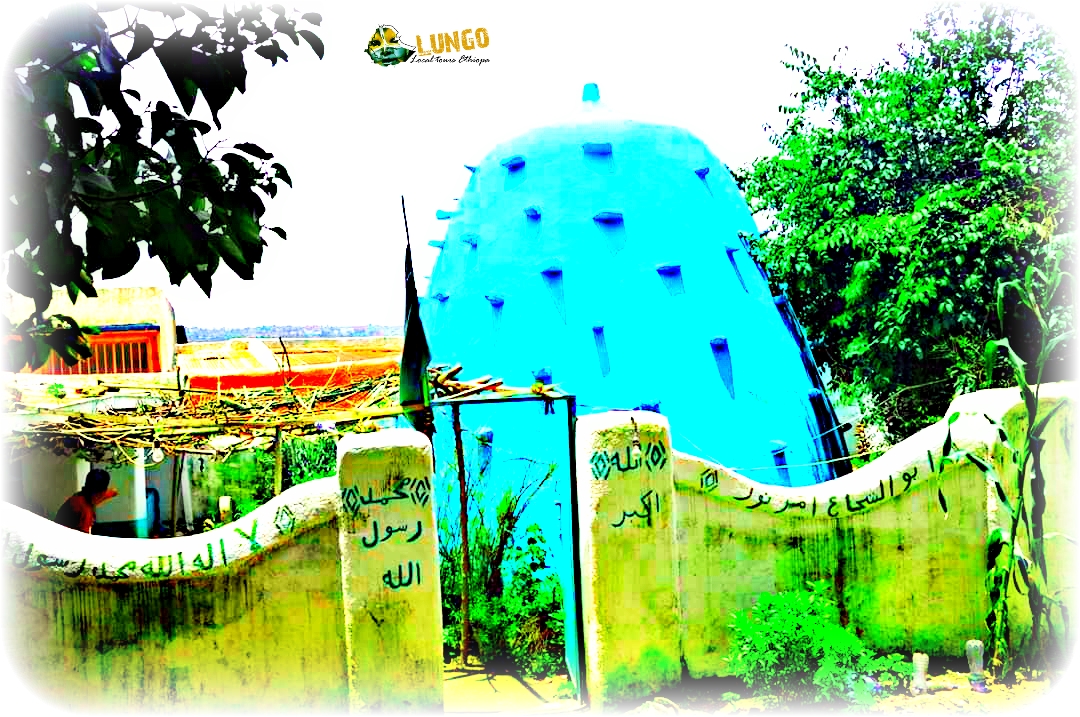Lungo Local Tour Ethiopia
Summary: East Ethiopia
Duration: 15 days 14 nights
Day 1: Bahir Dar – Monasteries of Lake Tana
Together with lungo local tour Ethiopia In the morning, we take a short flight to Bahir Dar (50 mins).
After we check-in to our hotel/lodge, we go for a city tour. Bahir Dar is situated on the shore of Lake Tana, the largest lake in the country with 37 islands, most of which have monasteries from the 14th-19th century. Bahir Dar has a Mediterranean type weather. Its palm-lined streets make Bahir Dar one of the most attractive cities in Africa. The city is the capital of the regional government for the Amhara people.
In the afternoon, we take a boat across Lake Tana to the Zeghie peninsula. On the peninsula, we do a short walk and visit two monasteries from the 14th century – Azwa Mariam and Ura Kidane Mehret. The architectural style of both monasteries is a typical example of the Ethiopian Orthodox Church, with its round shape, mud walls, and conical straw roofs. In Zeghie, we also find a diverse bird species and Columbus Baboons in the forest. After the walk, we will be invited to visit a local family for a typical tradition Ethiopian coffee ceremony. Overnight stay in a family-owned hotel/lodge.

Day 2: Bahir Dar – The Blue Nile Falls
In the morning we visit a local market to discover traditional handicrafts, jewelry, cotton scarves and straw baskets for which Bahir Dar is known for all over the country. After lunch, we will have an excursion to the magnificent Blue Nile waterfalls. The waterfall is locally known as ‘Tis-Issat’ which means “smoking water.” After driving for 40 minutes, we will have a short hike to the falls. The area around the falls is green and appealing for hiking. Overnight stay in a family-owned hotel/lodge.
Day 3: The Castles of Gondar
Our trip continues to Gondar (185 km) via a magnificent landscape of the Amhara region. The farmlands of the Amhara people are visible on the roadside. We will make a quick stop at Awra Amba community, an egalitarian society. Unlike other parts of the country, in the Awra Amba community women have equal rights as men, and there is no distinction in divisions of labor between men and women.
We then continue driving to Gondar. Gondar used to be the seat of many Emperors who ruled Ethiopia in the 17th and 18th century. The town is the gateway to the Simien Mountains and lies at an altitude of 2,200 meters above sea level. After lunch, we will visit the famous castles of the town, where former rulers built numerous palaces for themselves and their families. Afterwards, we will go to the bath of King Fasilidas, where Timkat fest is annually hosted. Timkat is one of the famous festivals in Ethiopia and held annually to celebrate the baptism of Jesus Christ. We finish the day with a visit to the church of Debre Berhan Selassie, which is famous for its beautiful ceiling paintings. The motif of the angelic face became a symbol of the Ethiopian art. Overnight at hotel.
Day 4: Simien Mountains National Park
Morning drive to Simien Mountains National Park (135 km). The Simien Mountains has been designated as a World Heritage Site by UNESCO since 1969. UNESCO described the mountains as “one of the world’s most spectacular landscapes on the Ethiopian plateau.” The park is full of breathtaking landscapes and abundant flora and fauna. Over 10,000 of the rare & endemic Gelada baboons live in the park and can be observed at a close distance. The park is also the home of the Walia Ibex, which is also called Ethiopian Wolf.
A local hiking guide and scouts (park rangers) accompany us for the park visit. We will have an easy hike (approx. 3 h) from Sankaber (3,260 m) to Geech. We pass picturesque scenery, as well as Ethiopia’s highest waterfall, Jinbar, also called “gateway to hell.” We will camp in Geech (3.600 m) for the overnight. It is situated on a huge plateau with horses grazing in the meadows. Overnight camping.
Day 5: Simien Mountains National Park
Together with lungo local tour Ethiopia Today’s hiking (approximately 4 to 5 hrs.) takes us to the best viewpoints of the Simien National Park, Imet Gogo (3,926 m). From here, we can enjoy a 360 ° panoramic view of the Simien Mountains. Ethiopia is not called the “roof of Africa” for nothing. Many of the country’s northern part is full of rugged terrains and escarpments, deep valleys and a high plateau. Simien Mountains are part of the Ethiopian highlands. The area is covered with massive walls of volcanic rocks, which fall over a thousand meters deep into steep gorges. Some regions of the park are still inhabited and cultivated at over 3,000 m. According to recent statistics, more than four thousand households live in the Simien Mountains National Park.
We continue hiking to the next observation point Seha (3.785 m), where we have a picnic for lunch. The last stop is Quedadit (3.760 m) before we go back to Geech Camp. Then we drive back to Debark town (60km) for an overnight stay in a hotel.

Day 6: Drive to Axum (260km)
We drive almost 260 km to Axum. The drive takes us through the spectacular landscapes adjacent to the Simien Mountains. Axum is the oldest political capital of ancient Ethiopia. The town used to be a major trade center for caravan traders along the Red Sea. Overnight in hotel.
Day 7: Axum: The Begining of Ethiopian Civilization
Today we visit Axum. Axum is a small ancient town in northern Ethiopia that lies at about 2,100 meters above sea level. The history of Axum goes back 3,000 years when the Axumite civilization flourished. During its peak, the kingdom was one of the four greatest powers of the ancient world. The town still exhibits some of the remains of Axumite and pre-Axumite times.
Axum is also one of the sacred places in Ethiopia. According to the Ethiopian Orthodox church, Axum’s church of Mary of Zion hosts the original Ark of the Covenant with the tablets of the Ten Commandments. We visit the gigantic stelae and obelisks of Axumite time, ancient king’s palaces, the Mary of Zion church and the palace of the legendary Queen of Sheba. Overnight in hotel.
Day 8: Drive to Gheralta Mountains – Hawzen
Drive to the rock-hewn churches of Gheralta (190 km). We will have a quick stop at Adwa Mountains, the greatest battlefield of the victorious Ethiopians against colonizer Italy in 1896. The attempt of the Italians to colonize Ethiopia was unsuccessful. Ethiopia has always remained an independent nation.
Next, we continue driving to the ruins of Yeha. Yeha is a small town with a 12-meter-high ruined temple. The temple is more than 2,500 years old built in Sabean architectural style. We continue driving through the semi-desert Tigray region with the different, yet extraordinary scenery. We will arrive at Hawzen around late afternoon. Overnight at Gheralta Lodge.
Day 9: Hiking Gheralta Mountains
Today we will have a hike to Gheralta Mountains. Our first hike is to the top of one of the mountains which takes almost two hours. The hike goes through some steep and narrow passages. On the top of the mountain, we will have a fantastic view of the dry land of Tigray region. Besides the view, there are two 14th century old rock-hewn churches called Mariam Korkor and Daniel Korkor. The view of the other mountains of Daniel Korkor is extraordinary. Then we hike down for lunch before the next hike.
After lunch, we hike to Abune Yemata Gughe. To enjoy a breathtaking view, we have to hike for another two hours. This part of the hiking needs a bit of physical fitness, as it includes climbing steep rock. Local farmers will also help you climb the rocks. They will even provide you with ropes so that you can climb comfortably. Once you climb up, you will be proud of yourself and rewarded with one of the best views of Gheralta Mountains and its nearby regions. There is also another rock-hewn church on the top of the mountain carved between the 9th & 11th century with paintings from the 14th century. Overnight at Gheralta Lodge in Hawzen.
Day 10: Drive to Lalibela
Together with lungo local tour Ethiopia After breakfast in Hawzen, we head to Labella which is about 400 km away. Lalibela, formerly known as ‘Roha,’ was the political capital in the 11th and 12th Century. Lalibela is considered as one of “the eighth wonders of the ancient world” because of its eleven rock-hewn churches from the 12th century. The town is named after King Lalibela, who built the churches. King Lalibela had a dream of making a “second Jerusalem” in his kingdom to be a pilgrimage site for Ethiopians.
According to historians, the carving of the churches from a single rock took 20 years. However, according to a local myth, which many locals believe, the carving of the churches took overnight because of the help of invisible angels. The architecture of these carefully carved churches remains one of the highlights of our tours to Ethiopia. Overnight in hotel or lodge.

Day 11: Churches of Lalibela and Cooking with an Ethiopian family
After breakfast, we will visit the first group of the world-famous churches of Lalibela. In this group of churches, there is Bete Medhane Alem, which means “House of Savior of the World.” Bete Medhane Alem is the largest monolithic church in the world. Its architectural style resembles a Greek temple. The church is home to the original Lalibela Cross known as “Afro Ayigeba.” In the corner of Bete Medhane Alem church, there are three empty tombs symbolically representing Abraham, Isaac, and Jacob of the Old Testament.
In the afternoon we will discover the second group of monolithic rock churches. Among them is the church Bete Giyorgis, probably the most famous, finest and well-designed of all churches of Lalibela. Bete Giyorgis is connected to the other churches by a tunnel and carved out of the rock in the form of a cross. In the evening, a special highlight awaits us. We will be guests of an Ethiopian family and cook our dinner together. We learn not only new delicious recipes but also gain an insight into the everyday life of the Ethiopians.
Day 12: Awash National Park
After breakfast, we take a short flight to Addis Ababa. From Addis, we continue to drive to Awash National Park (220 km). We do short hiking in Awash and visit a village of the Kereyu people. Overnight stay at a lodge inside the park
Day 13: Game Drive in Awash National Park & Harar
In the morning, we do a game drive in Awash National Park. We explore the park’s beautiful surroundings around the Awash River and its waterfalls, antelopes, crocodiles, gazelles, zebras, ostriches and colorful bird world. With luck, we even discover lions or leopards. Then we drive to Harar (310 km). In the night, we visit the “hyena man” on the outskirts. The Hyena man feeds the hyenas every evening. Here we can also try feeding hyena. Overnight stay in hotel
Day 14: The Walled City of Harar & Dire Dawa
In the morning, we will visit the ancient Islamic city of Harar. Harar is considered as the fourth-holy city of the Muslim world after Mecca, Medina, and Jerusalem. Harar was founded around 1000 years ago. Its rulers walled the town to protect it from enemies. Harar is recognized as a UNESCO World Heritage Site. Harar is known for its colorful markets, countless mosques, colorful houses, the unique Harari folk and the traditional basket handicrafts of the Hadare people.
After lunch, we drive 55 km to Dire Dawa. On the roadside of our journey, we see the farms of the Oromo people who cultivate grains, coffee and the famous light drug in Ethiopia called Khat. Khat is a stimulant drug mostly chewed by many young in the country. It is one of the export items of the country. We stop at a local market in Awedaye and see the Khat market. In Dire Dawa, we visit the oldest train station in the country and the market called Kefira. Overnight at hotel.

Day 15: Addis Ababa (End of our Ethiopia Tour)
Together with lungo local tour Ethiopia Today is our last day of the tour. We fly back to Addis Ababa. In Addis, you have enough time for the last souvenir shopping or visiting some parts of the city. We conclude our Ethiopia trip with dinner at a typical Ethiopian restaurant with traditional music and dance. Afterwards, we transfer you either to your hotel or the airport for your international flight.

For the above tour ittenerary package price quote do not hesitate to contact me.
We suggest a walking tour if you are interested in social life, living conditions, problems, development projects, politics and the many stories of the tribal people. That would allow you time to visit with families and observe their daily- life activities. It is good way to experience real life in Ethiopia.
The above itineray is an ideal normal touristic tour. But there will be many more things to do and places to visit. We prefer not to list them all here. That way we can keep your interests and desires as the focal point for the final itinerary. Possibly, the unwritten part of our trip will be the best part of all.
Walk in step with lungo
People to meet
Views to gaze
Stories to hear
Culture to attend and life to experience
My name is lungo (afework bezabhi)
For the above tour price detail:-
Contact lungo right now
AFEWORK BEZABHI (LUNGO)
Web: – www.localtourethiopia.com
e-mail:-lungo.adiss@gmail.com
Skype:-lungo local tour Ethiopia
WATS up:-lungo local tour Ethiopia
Mable: (+251913413740
Face book, linkidin, flikir, youtube, google+Twitter:-lungo local tour Ethiopia
A380 TOUR OPERATOR AND LOCAL GUIDE
Tour Operations Head:-lungo local tour Ethiopia & Tours Services Plc. (founded by Netherlands and run by Lungo from Addis Ababa, Ethiopia) Bole Road Kirkos Sub city, Kebele 01/18, House No 198
AFEWORK BEZABHI (LUNGO) Based on Omo valley & Addis Ababa, ETHIOPIA


